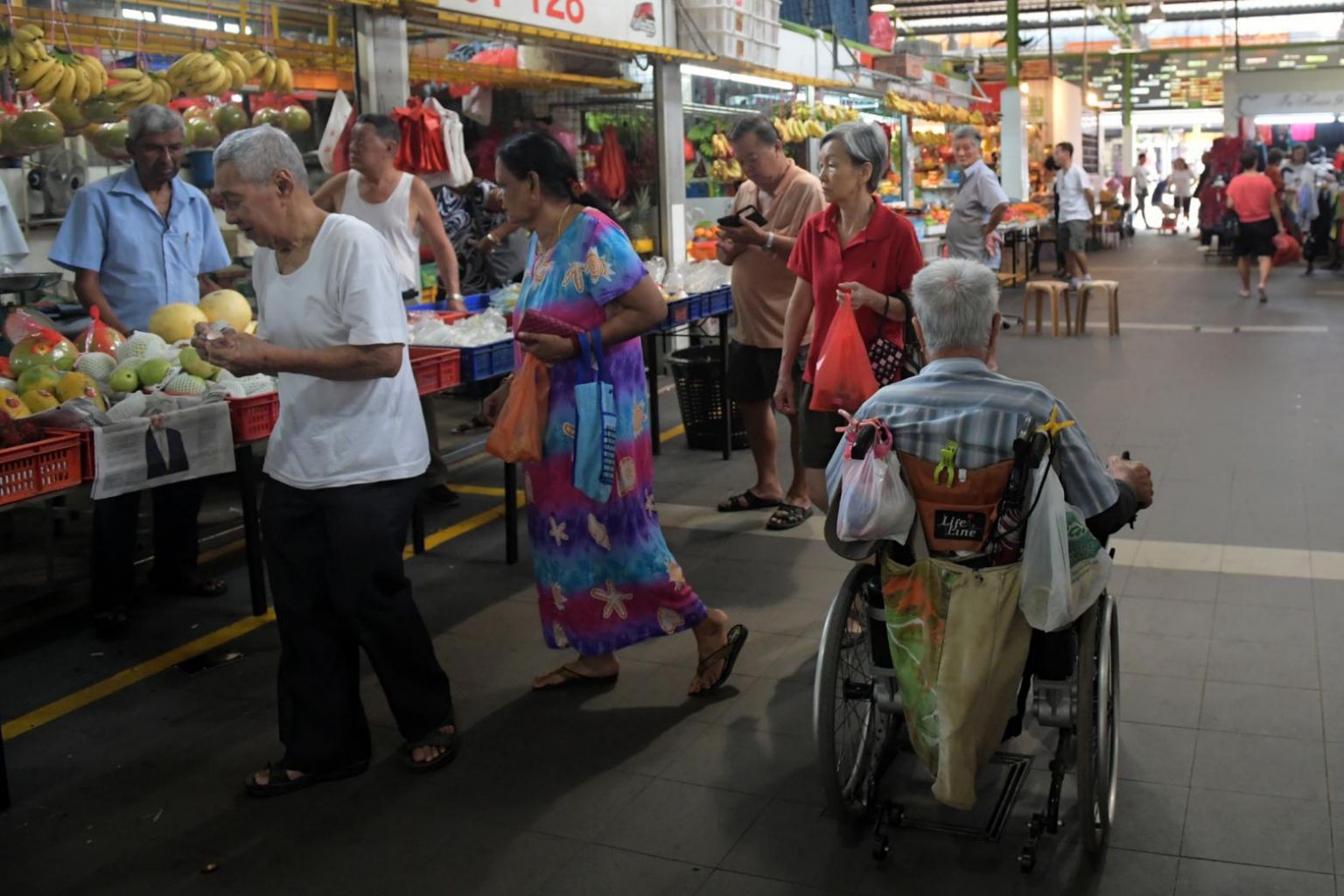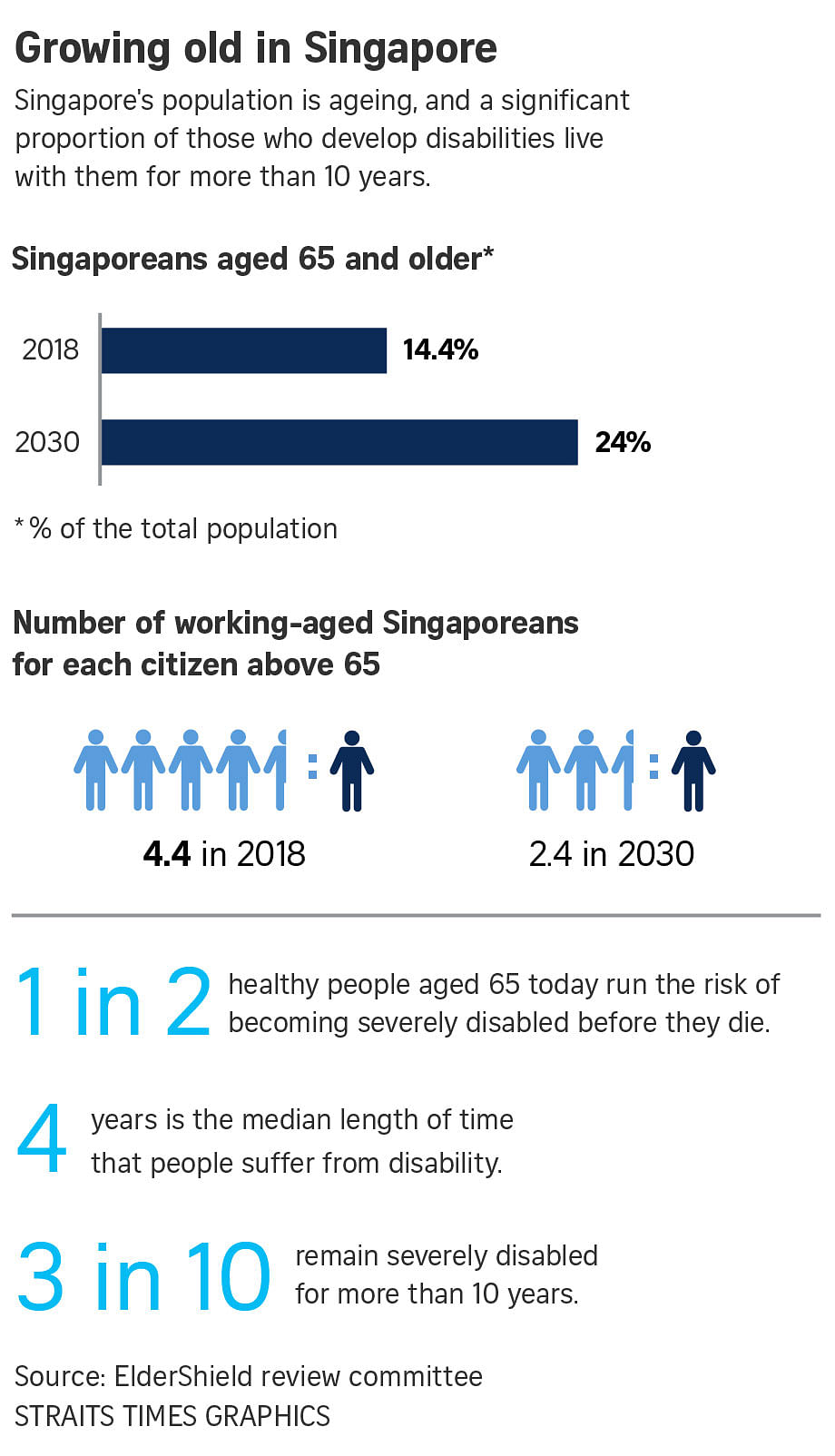ElderShield review committee proposes severe disability insurance scheme be made compulsory for future cohorts
Sign up now: Get ST's newsletters delivered to your inbox

Senior citizens at the newly opened Bukit Merah View Market and Food Centre on Jan 2, 2018.
ST PHOTO: JAMIE KOH
Follow topic:
SINGAPORE - ElderShield coverage should be made compulsory, including for those with pre-existing disabilities, said the committee reviewing the insurance scheme for people with severe disabilities.
It also recommended that people should start paying premiums at age 30 rather than 40 and suggested that the Government, rather than private insurance providers, should administer it. And it called for the claims process to be simplified.
If accepted, its proposals will only apply to Singaporeans aged 30 to 40 who are joining ElderShield for the first time. People who have previously opted out will not be made to go back on the scheme.
The committee gave its interim update on Tuesday (Jan 30), with the full set of recommendations expected to follow by the middle of this year.
"We want ElderShield to be a social safety net, and we all have a collective responsibility to take care of those with disabilities," said Mr Chaly Mah, who chairs the Eldershield Review Committee.
In a Facebook post on Tuesday, Senior Minister of State for Health Chee Hong Tat said that an enhanced ElderShield scheme would enable Singaporeans to "pool our risks and resources in preparation for old age."
"It is an important pillar of Singapore's social safety net as our society ages," he said. "The Government will look at providing premiums subsidies to keep the premiums affordable for lower and middle-income Singaporeans."
Currently, all Singaporeans join the scheme automatically when they turn 40, and are covered by one of three private insurers - Aviva, Great Eastern or NTUC Income - but they are able to opt out.
Although the opt-out rate in recent years is around 5 per cent, more than a third of people opted out when the scheme started in 2002.
Money is paid out when people cannot perform three of the six "activities of daily living", which include being able to wash, dress and feed themselves.
The six activities are: washing oneself in the bath or shower; wearing and unfastening all garments and putting on braces, artificial limbs or medical devices where required; to eat and drink without help; use the toilet to relieve themselves and manage the use of any protective undergarments or surgical appliances; move from room to room on level surfaces; and to transfer oneself from a bed to a chair or wheelchair, and vice versa.
Currently, those who joined the scheme between September 2002 and August 2007 are entitled to a monthly payout of $300 for five years. Those who joined after September 2007 - when the scheme was last enhanced - get a monthly payout of $400 for six years.
During the 2016 National Day Rally Speech, Prime Minister Lee Hsien Loong announced that the Government would form a committee to review the Eldershield scheme.
This was followed by a series of public consultations early last year, at which people raised issues such as who should manage the scheme and how to improve the claims process.
The committee has gathered feedback from more than 800 Singaporeans in 26 such sessions so far.
Mr Mah, who is also chairmain of Singapore International Chamber of Commerce and Singapore Accountancy Commission, said: "It is clear to us that the average Singaporean does not understand the risk of severe disability... when you underestimate this risk it is easy to take the decision to opt out."
Yet half of Singaporeans who are healthy at the age of 65 are at risk of developing a long-term disability over their lifetime, according to Health Ministry estimates.

In 2016, Mr Lee spoke of the need to adapt the scheme to an ageing population, adding that not everyone is covered under the existing scheme and six years of disability payouts may not be enough.
The committee said it is looking at the size of payouts and the duration for which they are given out, which could be different from the status quo. Premiums could also increase.
However, it is recommending that the Government helps low-income Singaporeans who may find it difficult to afford premiums.
Premiums are made yearly and differ based on the person's age when he signs up for the scheme. For instance, a man who enters ElderShield at 40 years old will pay about $ 175 every year in premiums until he turns 65. Meanwhile, a woman of the same age pays $218 annually.
But if one chooses to drop out halfway, he will not be entitled to any coverage.
In addition, people felt that having the Government as a single administrator would make the claims process easier to navigate, said Ms Chan Chia Lin, who chaired the government administration sub-committee.
"The feedback was that being a national scheme, it should be administered in a non-profit manner," added Ms Chia, who is director of private investment firm Holywell.
The committee also wants to make the process of making claims easier, including improving awareness of the scheme and making it more convenient for people to be assessed for it.
Dr Loh Yik Hin, who is chief executive of St Andrew's Community Hospital, said that many people may not know about the scheme and it is often challenging for caregivers to access one of the 140 general practitioners who are accredited to perform a disability assessment, especially if patients are bedbound.
"All this heightens the stress of the patient and the caregiver and we want to tackle this," said Dr Loh, who chaired the sub-committee for claims assessment.

